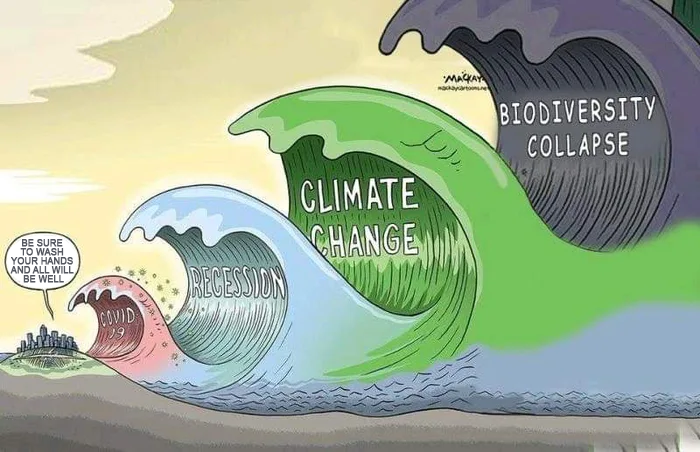2020 Q2: Nearly all environmental indicators were still going from bad to worse
Global warming
continued its relentless advance. After the first quarter had been the hottest in recorded history, the second started in the same vein.
- April 2020 was the second hottest April on record behind 2020
- May 2020 was the hottest May on record (tied with May 2016)
- June 2020 was the second hottest June on record
According to experts this means that 2020 is on course to become the hottest year since records began.
In May Siberia experienced an unprecedented heatwave with temperatures up to 10% above average, with spikes to 30ºC where 0ºC is normal.
All across the arctic temperatures have been rising much faster than elsewhere in the world. This is not only causing more and fiercer wildfires but is also thawing the permafrost, frozen peatland, which contains enormous quantities of greenhouse gases, such as CO2 and methane. Upon release those gases will severely speed up global warming, which will again increase thawing in a steadily worsening vicious cycle.
The thawing is also destabilizing the soil, which appears to have caused an ecological catastrophe in Russia in June, when at least 20,000 tons of diesel fuel leaked into local rivers. More such disasters will undoubtedly follow, because there are many storage pits for toxic petroleum waste across the arctic. They were supposed to remain permanently frozen but are melting and beginning to release their poisons into the environment.
All this is having a devastating effect on the wildlife and vegetation in the whole region.
In May a new study was published, showing that a billion people will either be displaced or forced to endure insufferable heat for every additional 1ºC rise in the global temperature. If current rates of emissions are continued, one third of the world's population will experience temperatures as high as the hottest parts of the Sahara within 50 years.
Mass extinction
In June new research showed that the extinction rate among terrestrial vertebrate species is significantly higher than formerly assumed. More than 500 species were lost during the last 100 years. Normally that would take 10,000 years. We are on course to lose 500 more in the next two decades.
Plastic waste is one of the major scourges of our world and will remain so for many hundreds of years. It is a long-term threat to all life, especially marine life, which is already under multiple other threats.
In the last few years it seemed that people were finally becoming aware of the magnitude of the problem. Even big business was reluctantly beginning to take action. The appearance of Covid-19 was enough to undo everything. It has caused plastic consumption to boom, with barely a thought for the long-term environmental impact, which will certainly be much worse than a temporary pandemic.
Face masks alone have become a major threat. Inspired by panic more than anything else their widespread use is a bad idea for many reasons.
- Most of them are sure to end up in the oceans, where they will do more damage to the marine environment. This alone should be reason enough not to use them at all, or only sparingly in cases where they are certain to do some good.
- In their vast numbers they cost a lot of money, especially when it is argued that everybody must wear them all the time, which is money withdrawn from other worthier causes.
- An overwhelming majority will be completely pointless (worn by healthy people among other healthy people).
- Their effectiveness is doubtful. Before Covid-19 numerous studies had been performed about the effectiveness of face masks as protection against similar diseases, leading to the conclusion that their effect was negligible. That also explains why at first many countries did not consider them a useful option. Science did not support their use. Since then there have been studies claiming that they do work, but they were rather hasty affairs and not the large-scale tests that could really settle the matter (so-called Randomized Controlled Trials), probably because those are very expensive, very difficult to execute properly and especially very time-consuming.
Overpopulation
This catalyst of all our other problems keeps on growing. In the first six months of 2020 another 42 million people, or almost the population of Spain, were added.
Deforestation
After more than 10,000 square miles of Brazilian rainforest were lost in 2019, this year threatens to become even worse. According to official figures deforestation in the Brazilian Amazon increased by a record 25% during the first half of 2020.
CO2
Concentrations of this major greenhouse gas continued their build-up in the atmosphere:
- April 2020 vs 2019: 416.18 vs 413.52
- May 2020 vs 2019: 417.16 vs 414.7
- June 2020 vs 2019: 416.39 v 413.93
Methane
This greenhouse gas is roughly 80 times more powerful than carbon dioxide, but only stays in the atmosphere for 10 years or so, while CO
2 may stay there for centuries. It has increased by a factor 2.5 since pre-industrial times. In April a report by the NOAA revealed that it in 2019 it had reached an all-time high, while its growth rate was one of the fastest in the last 20 years. It is produced by natural causes such as wetlands and by human causes such as the fossil fuel industry and livestock. It may be released in huge quantities if the above-mentioned thawing of permafrost continues.
Miscellaneous
- The COP26, the UN Climate Change Conference, was postponed, quite fittingly, on April Fools' Day. As those conferences are exercises in futility anyway, it does not matter much. Otherwise it would certainly have qualified as the sickest joke in human history.
- Planet of the Humans is a powerful and distressing movie about climate change and the environment, produced by Jeff Gibbs and promoted by Michael Moore. On 21 April it was released for free viewing on u-tube. Among other things it exposes flaws in the claims of wind and solar energy advocates, dubious relations between conservationists and industry and the harm that biofuels are doing to the environment. It has come under criticism for using outdated information and exaggerating some claims but its basic message, that renewables are by no means the magic wand to solve our environmental problems, is perfectly sound.
- Under the already unambitious Paris Agreement countries were supposed to submit "upgraded climate plans" in February 2020. Only 3 out of about 200 have done so. Not really a surprise because 2 UN reports from 2019 had already shown that most are on track to increase their fuel fossil production and emissions
Final thoughts
Events in the second quarter of this year demonstrated humanity's inability to handle even a minor disaster like the Covid-19 pandemic. Panic and hysteria reigned. When science offered no easy answers, medieval practices were used. Our leaders proved incapable of leading, terrified of making hard choices that might upset the masses. This bodes little good for the future, where much worse lies in store.
"The warnings about global warming have been extremely clear for a long time. We are facing a global climate crisis. It is deepening. We are entering a period of consequences."
Al Gore


